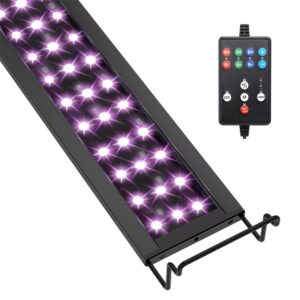Nocturnal fish species are unique aquatic animals that remain active during night hours. There are several reasons why they are active during the night. Reasons behind their nocturnal behavior, why they tend to be red, how to boost nocturnal fish color, and many other things are in the following. For further information, scroll down the page.
Content Table
Nocturnal Fish Meaning
The fish species are active during night or dark hours and hide during day or light hours. These are exactly the opposite of diurnal fish, which are active during the day and take rest or hide at night.
Examples
- Cardinalfish
- Kuhli loaches
- Suckermouth catfish
- Eels
- Soldier fish

nocturnal fish color
Why Nocturnal Fish Are Most Active At Night?
Nocturnal fish species remain active at night for various reasons. Here are some obvious reasons why nocturnal fish are most active at night.
To Avoid Predators
Nocturnal fish leave their hideouts at night to avoid being preyed on. Most of their possible predators are diurnal. Moreover, they effectively forge themselves at night to avoid being preyed upon by their possible nocturnal predators.
Fetching Food
As mentioned, they are excellent at forging themselves with their surroundings. Most of their prey species, i.e., zooplankton, are active at night. Therefore, they remain active during those hours.
Breeding
Some nocturnal species have timed their spawning activities according to the lunar cycle. To match it, they remain active at night.
Sensory Limitations
Nocturnal species have specialized sensory organs that perform optimally at night. For example, they have highly sensitive vision and hearing. They use that sensitive vision and hearing ability at night or in low-light conditions to prey on their food.
Avoid Competition
There is less competition for food and space, and they don’t like extreme competition.
Why Are Nocturnal Fish Red?
Numerous nocturnal fish species are red. Cardinalfish, Cherry Barbs, Lionfish, and some Moray eel species are examples of my statement. Here are the reasons why they appear red.
Self-defense Mechanism
Red color has a high wavelength, and it readily disperses in water. At a certain depth, the red appears to be black. These fish camouflage themselves to avoid being preyed upon.
Fetching Food
The red color makes them almost invisible at night, especially at high depths. At those depths, they used to prey on their food without being exposed to their potential prey.

nocturnal fish freshwater
Advices For Boosting Nocturnal Fish Color
A single piece of advice to boost coloration is “Give them a home-like vibe or mimic their natural habitat.” Here are some ways to enhance your fish coloration.
Lighting
Avoid bright lights. Instead, use some relaxing and dim LED lights, i.e., dimmed blue or moonlight. These lights will recreate their natural habitat.
Feeding
Always feed them at night or when the lights are off. It is their peak activity time, and they eat well during these hours.
Color Enhancing Diets
Feed them on carotenoid-rich food like astaxanthin and lutein. Atlantic krill, crab meal, yeast, and crayfish meal are natural color-enhancing food items.
Dark Substrate
Use a dark substrate in the tank, i.e., dark-brown or black gravel. This dark color will highlight coloration.
Natural Environment
Fill your tank with natural habitat items, e.g., rocks, plants, driftwood, etc. These items will simulate their natural environment, which helps to boost their coloration.
Complementing Tank Mates
Never stock aggressive or diurnal fish species with them. It’ll cause stress among your nocturnal species and result in loss of coloration.
Maintain Water Quality
Water quality also affects the coloration of your nocturnal fish. Therefore, maintain optimal water quality in the tank.
- Change 20 to 30% volume weekly.
- Use gentle filtration in the tank.
Wait
Always give them some room to acclimate to a new environment. Once they sync with the new setup, you’ll see their faded colors turn into bright coloration.

boost nocturnal fish color
Nocturnal Fish Species For Freshwater Aquariums
Several nocturnal species are there. However, the most famous 5 nocturnal fish species for freshwater are as follows.
Bristlenose Pleco
Ancistrus spp., or Bristlenose pleco, is among the famous nocturnal freshwater fish. Their bristly snout is the most highlighted feature. This feature is more visible in males. They have a calm temperament and are known for their algae-eating habit. For this reason, aquarists keep them as tank cleaners.
| Feature | Information |
| Size | 4 to 6″ |
| Optimal water temperature | 72–82°F |
| pH | 6.5 to 7.5 |
| Life expectancy | 5 to 8 years |
| Dietary preference | Herbivores |
| Lighting requirement | low |
Kuhli Loach
Pangio kuhlii, or Khuli loach, is another famous freshwater nocturnal fish. They have a snake-like body. They appear like a tiny, striped eel. They tend to be very calm and shy. As mentioned, they are active at night. Their activity is highly visible when they move in small groups. They create a worth watching scenery in low light.
| Feature | Information |
| Size | 3 to 4″ |
| Optimal water temperature | 75 to 86°F |
| pH | 5.5 to 7.0 |
| Life expectancy | 7 to 10 years |
| Dietary preference | Omnivore |
| Lighting requirement | low |
Black Ghost Knifefish
Apteronotus albifrons, or black ghost knifefish, has a flowing ribbon-like body. Their elegant jet-black makes them eye-catching. Usually, they remain peaceful and intelligent as, over time, they can recognize their keeper. They use a weak electric field for hunting and moving in the dark waters. Moreover, it’s worth watching to observe their movement in the dark.
| Feature | Information |
| Size | 14 to 20″ |
| Optimal water temperature | 73 to 82°F |
| pH | 6.5 to 7.5 |
| Life expectancy | 10 to 15 years |
| Dietary preference | Carnivore |
| Lighting requirement | Dim |

Nocturnal Fish Species
Glass Catfish
The glass catfish is another famous nocturnal freshwater fish species. They are known for their transparent body. One can even see through to their bones and body organs. They have schooling behavior. Due to their delicacy, they can only live in optimal water parameter conditions, besides calm and compatible tank mates.
| Feature | Information |
| Size | 4 to 5″ |
| Optimal water temperature | 75 to 80°F |
| pH | 6.5 to 7.5 |
| Life expectancy | 5 to 8 years |
| Dietary preference | Omnivore |
| Lighting requirement | Low and diffuse |
Synodontis nigriventris
As the name suggests about its movement. They swim upside-down and usually tend to live under the shade of the aquarium trees’ leaves. They do so to create ease in grazing on algae or biofilm. Aquarists keep them to add an entertainment factor besides tank cleaning. You can keep these nocturnal species in small schools.
| Feature | Information |
| Size | 3 to 4″ |
| Optimal water temperature | 72 to 82°F |
| pH | 6.0 to 7.5 |
| Life expectancy | 5 to 8 years |
| Dietary preference | Omnivore |
| Lighting requirement | Medium to low |
Rounding Out the Discussion
Nocturnal fish species show a unique behavior to avoid competition, super-sensitive body organs, etc. Their red color helps to camouflage them in deep waters, as the red color turns to black at greater depths. You can boost their coloration with an optimal diet and in the natural environment. In the end, some unique nocturnal fish species are a special gift for you if you want to enjoy this dark-hour beauty in your comfort space.


Leave a comment